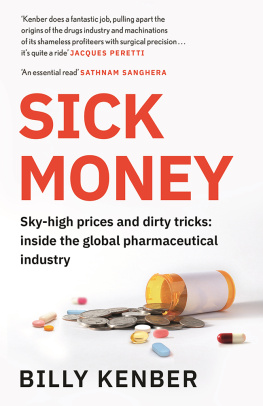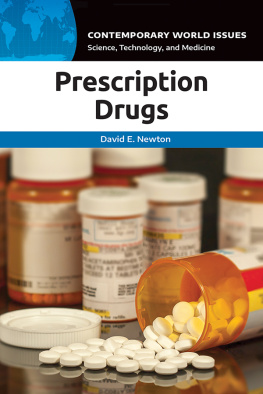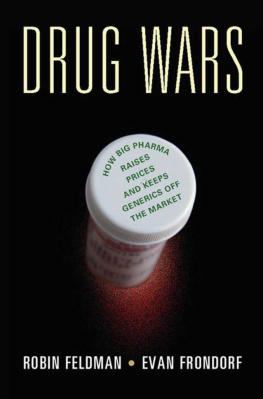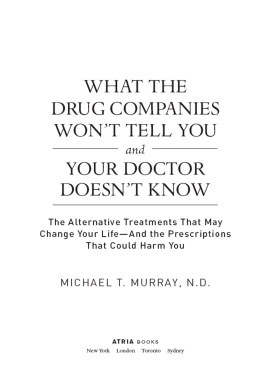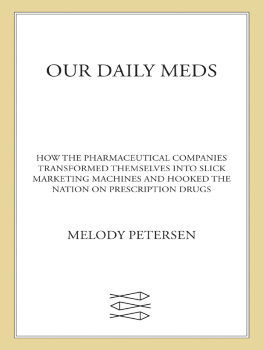
Well plug along on it for two or three years, and maybe well get something permanentand probably well fail.
Martin Arrowsmith

For my children and grandchildren
University of California Press
Berkeley and Los Angeles, California
University of California Press, Ltd.
London, England
2004 by the Regents of the University of California
Library of Congress Cataloging-in-Publication Data
Goozner, Merrill, 1950.
The $800 million pill : the truth behind the cost of new drugs / Merrill Goozner.
p. cm.
Includes bibliographical references and index.
ISBN 0-520-23945-8 (cloth)
1. Prescription pricing. 2. DrugsPrices.
3. Pharmaceutical industry. 4. Consumer education.
I. Title: Eight hundred million dollar pill. II. Title.
RS100.G668 2004
338.4'3'61510973dc22 | 2003063422 |
Manufactured in the United States of America
10 09 08 07 06 05 04
10 9 8 7 6 5 4 3 2 1
The paper used in this publication meets the minimum requirements of ANSI/NISO Z39.48-1992 (R 1997) (Permanence of Paper). 
Contents
Introduction
In the quarter-century since the dawn of the biotechnology revolution, hundreds of research scientists at the nations elite medical schools have decamped from their tenured sinecures to join pharmaceutical firms or biotechnology start-ups. Most have set up shop near the institutions that trained themnear Boston, San Francisco, San Diego, or Research Triangle Park in North Carolina. Others have gravitated to the outskirts of Washington, D.C., to be near the National Institutes of Health (NIH), the funding colossus of the biomedical world. Most see themselves as dedicated scientists in the mold of Martin Arrowsmith, the fictional physician in Sinclair Lewiss novel, whose passion to make a mark in the world of research was always leavened by his abiding concern for the health of mankind. But virtually all have lurking somewhere in the corners of their minds another goal. They want to start the next Amgen.
Amgen Inc., however, did not spring from any of the intellectual command posts of the biotechnology revolution. It began in an office park in Thousand Oaks, a skateboard haven about an hours drive north of Los Angeles, far enough from downtown that local inhabitants sometimes refer to it as Thousand Miles. In that small city of cookie-cutter ranch homes and enclosed shopping malls, a handful of scientists trained at the University of California at Los Angeles and skilled in the new art of recombinant engineering began in 1980 what would eventually become the largest, fastest-growing, and most profitable biotechnology company in the world.
One of the first companies to bring a biotechnology product to market, Amgen has grown to more than eight thousand people working in forty buildings sprawled across its industrial parklike campus. Though Amgen attracted only a handful of top-notch scientists to move there over the years, the company registered nearly $5 billion in sales in 2002 and declared almost a third of that in profit. According to Forbes Magazine, investors who plunked down one hundred dollars for stock in the struggling start-up in the mid-1980s would have shares worth more than $1.5 million by 2001, making Amgen one of the business worlds most extraordinary growth stories in the decades when such stories were commonplace.
Yet for all of Amgens spectacular success, virtually all of the companys revenue came from the sale of just two drugs. Both gained approval from the Food and Drug Administration during George H. W. Bushs administration. Both were considered the low-hanging fruit of the biotech revolution, easy targets for the new technology of recombinant engineering. Amgens big sellers are artificial versions of naturally occurring enzymes that had been identified and isolated well before the company began developing them.
Amgens first approved drug and its biggest seller is Epogen. It is the recombinant-engineered version of erythropoietin, the enzyme produced in the kidney that signals bone marrow to manufacture red blood cells. The largest patient population in need of erythropoietin is the more than three hundred thousand Americans on dialysis. Their failing kidneys no longer produce it in sufficient quantities to prevent anemia. The federal government picks up the tab for most dialysis patients through the Medicare program, meaning Amgens financial success has largely come at taxpayer expense. Amgens other big seller is Neupogen, an artificial version of granulocyte colony-stimulating factor, which tells the bone marrow to produce infection-fighting white blood cells. This drug is a godsend to cancer patients undergoing chemotherapy, whose suppressed bone marrow is in need of extra stimulation.
The health benefits derived from these drugs have come at a hefty price. They are among the most expensive on the market. This is not because the drugs are costly to make. The technology behind recombinant engineering, invented in the mid-1970s, is now rather commonplace and can be conducted by intelligent college students working with lab equipment ordered over the Internet. Nor is the high price justified by the original investment in research and development. Amgen earned the cost of developing these drugs within a year or two of their coming on the market.
Rather, as Amgens extensive advertising on National Public Radio, in magazines, and in the medical literature puts it, there is only one justification for the high price tags on its drugs. They are needed to pay for the scientists and technicians squirreled away in Thousand Oaks, who are busily searching for the next generation of wonder drugs. It costs more than $800 million to discover a new drug, industry officials have said, drawing their figure from a single, frequently cited study from Tufts University. They have to put a high price on yesterdays discoveries if they are going to conduct the research needed to come up with the next generation of wonder drugs. One set of recent Amgen ads featured a clinician clad in a lab coat peering into a microscope. The caption claimed the company was searching for therapies capable of dramatically improving peoples lives.
Half of Amgens employees and one of every five dollars earned over the past decade was in fact devoted to what the company called research and development. Yet Amgens labs were notoriously unproductive in the decade after its first drugs were approved. Its been a while since a major clinical advance has come out of Thousand Oaks, said Mark Brand, a marketing professor at Johnson and Wales University in Denver who used to be the companys top public relations man. Their offerings to physicians have not been major league.
In late 2001, after a decade of disappointments, the companys labs finally produced a new drug capable of generating a billion dollars in salesthe financial holy grail of pharmaceutical industry managers and investors. The drug is called Aranesp. The company touted Aranesp as its most significant medical advance since the arrival of its first two drugs. But Aranesp, like Epogen, was for anemia. Was it a dramatic new treatment for the debilitating condition? Company officials said it was. We believe Aranesp simplifies the treatment of anemia associated with chronic renal failure, with potentially fewer office visits and less disruption to patients lives, Kevin Sharer, the chief executive officer of Amgen, said.
Next page

